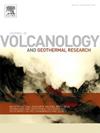智利南安第斯山脉Lonquimay火山群全新世中晚期喷发前条件
IF 2.3
3区 地球科学
Q2 GEOSCIENCES, MULTIDISCIPLINARY
Journal of Volcanology and Geothermal Research
Pub Date : 2025-08-09
DOI:10.1016/j.jvolgeores.2025.108425
引用次数: 0
摘要
龙奎迈火山群(38°22'S, LVC)是安第斯山脉南部火山带最活跃的火山之一。它由一个主要的复合火山和12个单生锥组成,自上更新世以来一直喷发。它最近一次喷发是在1988 - 1990年,对人类健康和环境造成了灾难性的后果。在这里,我们估计并比较了复合火山中三个暴露最充分、分布最广的瀑布沉积物和火山复合体的三个熔岩的喷发前关键条件(压力、温度、溶解水含量和结晶度)。为分析的火山喷发提供岩浆的成分为玄武岩至粗灰岩,含有斜长石±橄榄石±斜辉石以及少量铁钛氧化物和磷灰石的矿物组合。演化单元含有独特的铁质自晶(低至Fo21),它们被认为是在岩浆(1)低压下形成的,(2)具有演化成分,(3)高铁含量,(4)还原状态。基于地球化学和热气压计算,我们提出了两个岩浆储存区:(1)一个较深的热基性储存区(~ 12 km),其中包含1083-1151℃的玄武岩-玄武岩-安山岩岩浆,这些岩浆经历了拉斑基性注入;(2)一个较冷且演化的喷发-岩浆系统,其主要储存区位于5.6 km处,岩浆位于869-1046℃,其中发生了部分结晶、岩浆注入、混合和对流。虽然认为爆发喷发和喷涌喷发具有相同的岩浆注入和混合触发机制,但我们认为混合时间尺度以及挥发性成分和微晶含量在控制喷发方式方面起着关键作用。本文章由计算机程序翻译,如有差异,请以英文原文为准。
Pre-eruptive conditions of Mid-to-Late Holocene eruptions from Lonquimay Volcanic Complex, Southern Andes of Chile
Lonquimay Volcanic Complex (38°22′S, LVC) is one of the most active volcanoes in the Southern Volcanic Zone of the Andes. It comprises a main composite volcano and twelve monogenetic cones, and it has erupted since the Upper Pleistocene. Its latest eruption was in 1988–90 and had catastrophic consequences for the human health and environment. Here we estimated and compared key pre-eruptive conditions (pressure, temperature, dissolved H2O content and crystallinity) from three of the most well-exposed and widespread fall deposits from the composite volcano, and three lavas of the volcanic complex. Magmas that fed the analysed eruptions were basaltic to trachytic in composition and contained a mineral assemblage of plagioclase±olivine±clinopyroxene and minor Fe![]() Ti oxides and apatite. Evolved units contain unique fayalitic autocrysts (as low as Fo21), which are proposed to have formed in a magma (1) under low pressure, (2) with an evolved composition, (3) a high Fe content, and (4) a reducing state. Based on geochemistry and thermobarometric calculations, we suggest two magma storage zones: (1) a deeper hot and mafic storage region (∼12 km) that host basaltic to basaltic-andesitic magmas at 1083–1151 °C, which undergo tholeiitic mafic injections and (2) a cooler and evolved eruption-feeding magmatic system with a major storage region at 5.6 km with magmas at 869–1046 °C, where fractional crystallisation, magma injections, mingling, and convection took place. Although the same magma injection and mingling triggering-mechanism is suggested for explosive and effusive eruptions, we suggest mingling timescale plays a key role in controlling eruptive style, along with volatile composition and microcryst content.
Ti oxides and apatite. Evolved units contain unique fayalitic autocrysts (as low as Fo21), which are proposed to have formed in a magma (1) under low pressure, (2) with an evolved composition, (3) a high Fe content, and (4) a reducing state. Based on geochemistry and thermobarometric calculations, we suggest two magma storage zones: (1) a deeper hot and mafic storage region (∼12 km) that host basaltic to basaltic-andesitic magmas at 1083–1151 °C, which undergo tholeiitic mafic injections and (2) a cooler and evolved eruption-feeding magmatic system with a major storage region at 5.6 km with magmas at 869–1046 °C, where fractional crystallisation, magma injections, mingling, and convection took place. Although the same magma injection and mingling triggering-mechanism is suggested for explosive and effusive eruptions, we suggest mingling timescale plays a key role in controlling eruptive style, along with volatile composition and microcryst content.
求助全文
通过发布文献求助,成功后即可免费获取论文全文。
去求助
来源期刊
CiteScore
5.90
自引率
13.80%
发文量
183
审稿时长
19.7 weeks
期刊介绍:
An international research journal with focus on volcanic and geothermal processes and their impact on the environment and society.
Submission of papers covering the following aspects of volcanology and geothermal research are encouraged:
(1) Geological aspects of volcanic systems: volcano stratigraphy, structure and tectonic influence; eruptive history; evolution of volcanic landforms; eruption style and progress; dispersal patterns of lava and ash; analysis of real-time eruption observations.
(2) Geochemical and petrological aspects of volcanic rocks: magma genesis and evolution; crystallization; volatile compositions, solubility, and degassing; volcanic petrography and textural analysis.
(3) Hydrology, geochemistry and measurement of volcanic and hydrothermal fluids: volcanic gas emissions; fumaroles and springs; crater lakes; hydrothermal mineralization.
(4) Geophysical aspects of volcanic systems: physical properties of volcanic rocks and magmas; heat flow studies; volcano seismology, geodesy and remote sensing.
(5) Computational modeling and experimental simulation of magmatic and hydrothermal processes: eruption dynamics; magma transport and storage; plume dynamics and ash dispersal; lava flow dynamics; hydrothermal fluid flow; thermodynamics of aqueous fluids and melts.
(6) Volcano hazard and risk research: hazard zonation methodology, development of forecasting tools; assessment techniques for vulnerability and impact.

 求助内容:
求助内容: 应助结果提醒方式:
应助结果提醒方式:


